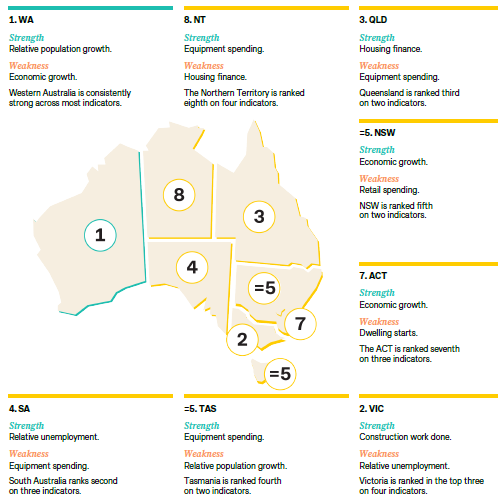But more mortgage-sensitive states could pull ahead soon

Western Australia has topped the CommSec (Commonwealth Bank’s securities platform)’s State of the States economic leaderboard for the third consecutive quarter.
Australia’s largest state ranked first for retail spending, relative unemployment, population growth, housing finance, and dwelling starts.
CommSec’s chief economist Ryan Felsman highlighted that WA’s “strong relative population growth has boosted labour and housing markets, encouraging consumers to spend”.
WA’s retail boom
Retail trade data for the December 2024 quarter showed retail spending remained above long-term averages in all Australian states and territories.
Yet it was WA that led with real spending 11.5% higher than its decade average, followed by Victoria and Queensland.
 Image credit: CommSec
Image credit: CommSec
The ACT ranked fourth, while South Australia rose to fifth. The Northern Territory recorded the smallest gain, up 1.4%, behind Tasmania and NSW.
If nominal monthly retail trade for February 2025 was used, WA would still lead, ahead of Victoria and Queensland. In February 2025, annual nominal spending growth was fastest in Western Australia, followed by Victoria.
Jobs galore
WA has the strongest job market, based on unemployment rates compared to decade averages.
In March 2025, trend unemployment in WA was 3.5%, or 32.1% below its decade average. South Australia followed with a 3.9% jobless rate while Tasmania moved to third place, ahead of Queensland.
Victoria ranked last with a 4.5% unemployment rate, 11.1% below its decade average. NSW, the Northern Territory and the ACT also ranked above Victoria.
Employment levels were above decade averages across all states and territories. Western Australia led with employment 15.9% higher than the long-term average.
Sticky home prices
Annual consumer price inflation eased across all eight capital cities in the December 2024 quarter. WA capital Perth recorded the highest annual inflation at 2.9%, ahead of Adelaide and Melbourne.
With inflation easing and wage growth remaining strong, all states and territories recorded positive real wage growth in the quarter. Nationally, headline CPI rose 0.2% in the quarter, while the annual rate slowed from 2.8% to 2.4%. Underlying inflation eased from 3.6% to 3.2%.
The Wage Price Index rose strongest in Tasmania (3.9%), followed by Queensland and the ACT.
Home prices rose in all states and territories except Victoria, Tasmania and the ACT in March 2025. National home prices grew 3.4% over the year, down from 4.9% in December.
Western Australia recorded the strongest home price growth at 11.9%, ahead of South Australia and Queensland.
Where is WA lagging?
Western Australia is lagging other states in construction and equipment investment growth, despite modest improvements. In the December 2024 quarter, the total real value of residential, commercial and engineering work completed in WA was 12.6% above the decade average.
This performance placed WA third nationally, behind Victoria (up 15.1%) and South Australia (up 13.9%).
In terms of new plant and equipment investment, WA was up 25.1% compared to the decade average, placing the state second behind Tasmania, which recorded a 25.7% rise.
The year-on-year analysis paints a weaker picture. Equipment investment in WA fell by 2.2% over the year to December 2024, placing it among the poorer performers alongside Queensland (down 4.9%), the ACT (down 3.5%) and Victoria (down 0.7%).
Will WA keep outperforming?
“If we focus just on annual growth rates, on an aggregate basis (looking across all indicators), resources-focused states Western Australia and Queensland both have the strongest annual economic momentum, supported by robust housing markets and solid population growth,” Said CommSec.
Analysts noted that WA and Queensland are expected to continue their recent domination of the rankings in early 2025. “While Western Australia tightened its grip atop the national economic leaderboard, both Queensland and South Australia slipped back from joint second to third and fourth places, respectively, losing some momentum.”
Looking ahead, there are risks that could affect Western Australia’s outlook. The escalating US-China trade war could impact the state's economy due to its heavy reliance on commodity exports to China.
While expected interest rate cuts may lift sentiment across the country, their positive effects are likely to be more pronounced in mortgage-sensitive states like New South Wales and Victoria rather than in Western Australia.



